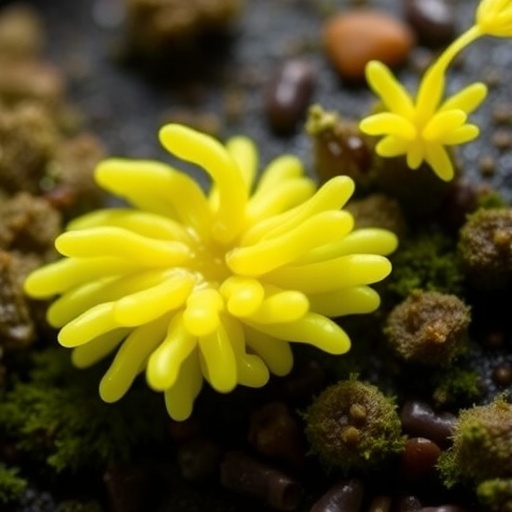In a groundbreaking advancement for sustainable agriculture, researchers at Sophia University in Japan have unveiled a novel approach to combating root-knot nematodes (RKNs) using metabolites secreted by cellular slime molds. Root-knot nematodes, belonging to the genus Meloidogyne, represent a formidable challenge to global crop production, ravaging roots and causing widespread wilting and plant death. Each year, these microscopic parasites account for an estimated $173 billion in crop losses worldwide. Traditional reliance on chemical pesticides, although effective at curbing nematode populations, often results in collateral damage to beneficial soil microorganisms, ultimately compromising soil health and fertility.
The pressing need for environmentally benign pest control measures has propelled a team led by Professor Tamao Saito to explore the chemical ecology of Dictyostelium discoideum, a cellular slime mold known for its sophisticated chemical signaling and social behavior among individual cells. Previous findings hinted at the nematode-repellent properties of slime mold secretions, yet the specific bioactive compounds responsible remained unidentified. The current study is a significant leap forward, isolating and characterizing the molecular entities that mediate repellency, thus opening avenues for developing eco-friendly nematicides derived from natural sources.
Employing a conditioned medium (CM) methodology, the researchers cultivated slime mold cells, suspending them in buffered water for three days to accumulate secreted metabolites. These metabolites were subsequently dried and reconstituted to test their efficacy against RKNs. Profound repellency was observed: at a concentration of 30 mg/mL, the CM inhibited 99% of egg hatching and lethally affected nearly all juvenile nematodes. Even at a reduced dosage of 3 mg/mL, CM achieved substantial suppression, with 81% egg mortality and a 71% juvenile kill rate. Complementary in vivo assays on tomato seedlings corroborated these findings, with treated plants exhibiting markedly reduced root infection and enhanced aboveground growth over two months.
The chemical profiling of CM unveiled 14 distinct organic compounds responsible for nematode repellency. This consortium comprises four L-type basic amino acids, five carboxylic acids, a triad of antioxidants, alongside norepinephrine and pyridoxine. Intriguingly, while individual compounds displayed varying degrees of effectiveness in soil tests, their combination engendered a synergistic effect, significantly amplifying repellency. This synergy suggests a complex multimodal mechanism, whereby multiple chemical signals concurrently trigger nematode avoidance behaviors more effectively than any single agent alone.
Further experimentation quantified this synergy, revealing that a minuscule 0.01 mg mixture of the 14 compounds matched the repellency of 5 mg of the crude CM. Such potency underscores the potential for highly efficient, low-dose applications that minimize environmental impact. Since these metabolites are naturally occurring and biocompatible, large-scale deployment would likely preserve soil microbiota diversity and fertility, contrasting sharply with conventional synthetic nematicides.
Professor Saito emphasizes the importance of integrating these biologically-derived repellents into sustainable pest management frameworks. The prospect of utilizing cellular slime mold metabolites as part of an integrated approach aligns with global efforts to reduce harmful agrochemical use while safeguarding food security. This innovation offers a dual advantage: robust nematode control coupled with soil ecosystem preservation, a critical balance for long-term agricultural productivity.
Looking ahead, the research team is poised to dissect the molecular and genetic underpinnings of nematode repellency. Understanding how RKNs perceive and respond to this cocktail of metabolites at the receptor and signaling pathway levels remains a crucial frontier. Such insights could refine application strategies and facilitate the engineering of even more targeted biopesticides. This mechanistic elucidation will also clarify how multiple signaling pathways interact synergistically to modulate nematode behavior, potentially inspiring novel approaches to other agricultural pests.
This study’s significance extends beyond the laboratory, demonstrating the utility of chemical ecology and metabolic profiling in addressing entrenched agricultural challenges. By harnessing the intricate chemical language of soil microorganisms like Dictyostelium discoideum, scientists are forging new tools to enhance crop resilience naturally. This sustainable paradigm holds promise not only for nematode management but for a broader spectrum of plant health interventions that favor ecological balance.
Prof. Saito’s team published these findings in the Journal of Agricultural and Food Chemistry, underlining the interdisciplinary nature of the work spanning biochemistry, molecular biology, and agriculture. Their approach exemplifies how fundamental biological research can be translated into applied solutions, marrying scientific curiosity with practical crop protection. Given the escalating urgency to reduce agrochemical footprints amid global climate stressors, such innovations assume even greater urgency.
The implications for global agriculture are profound. Root-knot nematodes threaten food security by weakening staple crops. Deploying slime mold-derived repellents can decrease reliance on harmful pesticides, restore soil vitality, and thus sustain agricultural ecosystems. As the world grapples with feeding a growing population sustainably, this discovery of naturally sourced nematode repellents epitomizes the kind of scientific breakthrough poised to make a tangible difference.
Ultimately, this pioneering research charts a visionary pathway for integrated pest management. By leveraging nature’s chemical defenses encoded within slime mold metabolites, scientists are crafting potent, safe, and sustainable methods to safeguard crops. The convergence of chemical ecology, molecular biochemistry, and agronomy heralds a new chapter in pest control—one that respects the complexity of ecosystems while delivering effective agricultural protection.
Subject of Research: Cells
Article Title: Identification of Slime Mold Metabolites That Confer Protection to Commercial Crops against Root-Knot Nematodes
News Publication Date: 6-Aug-2025
References:
Kana Y. Hayashi, Yukiko Nagamatsu, Moemi Kawano, Sayaka Fuchimoto, Tsuyoshi Araki, and Tamao Saito. “Identification of Slime Mold Metabolites That Confer Protection to Commercial Crops against Root-Knot Nematodes.” Journal of Agricultural and Food Chemistry, 2025. DOI: 10.1021/acs.jafc.5c04345
Image Credits: Professor Tamao Saito, Sophia University, Japan
Keywords: Root-knot nematodes, cellular slime mold, Dictyostelium discoideum, nematode repellents, sustainable agriculture, soil fertility, integrated pest management, organic compounds, chemical ecology, metabolic profiling, crop protection, biopesticides
Tags: agricultural biotechnology advancementschemical ecology in agriculturecrop protection innovationsDictyostelium discoideum researcheco-friendly nematicidesenvironmentally safe pesticidesnatural pest repellentsnematode pest managementroot-knot nematode controlslime mold metabolitessoil health preservationsustainable agriculture solutions





